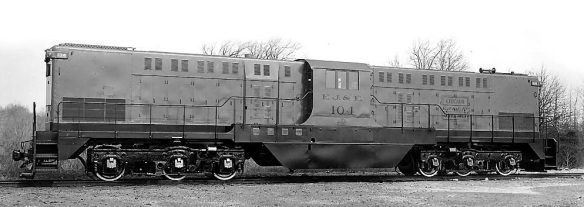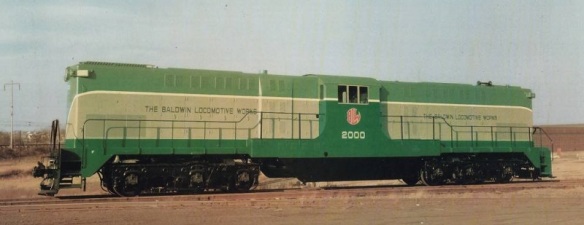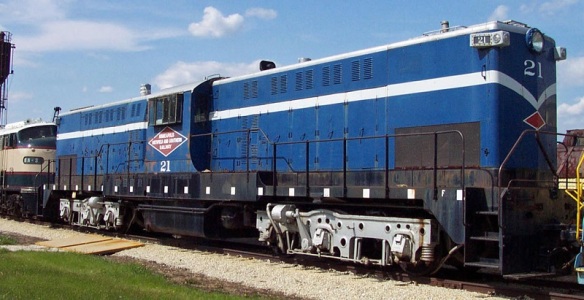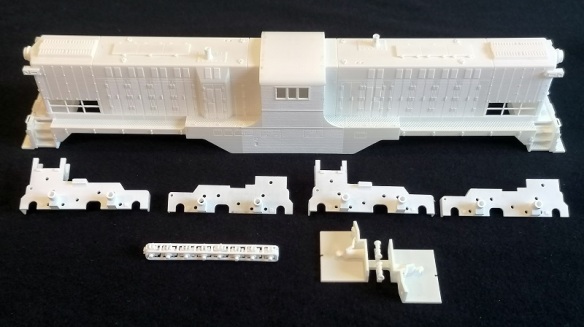As with all my projects, the further I get into them the more I find out about the real locomotive. As this model is HO, roughly twice the size of my first N scale version, a lot of the details are more visible, and this means they stand out more if I get them wrong. I’m in the process of drawing up the brass additions and I realized I hadn’t accounted for the sun visors often depicted in the photos of the originals. But the more I looked into this the more I realized there were lots of varieties. So in this post, I’ll share some of those with you and explain how I can make it easy to model the right one for you.
My original model in N Scale was based on Santa Fe’s No. 2601, and so will be the first HO model. But the first actual Baldwin DT6-6-2000 as originally delivered went to the Elgin, Joliet, and Eastern Railway as a demonstrator and is pictured below. Several things stand out to me about this loco, compared to the SF 2601. The grills at each end are at the top of the hoods, there’s no large shaped plate covering the fuel tank, there are no walkways at each end (which apparently was done to shorten the locomotive), the horn is on the side of the hood, there’s a handrail on the side of the hoods either side of the cab, there are round items on the roof which may be fans, and the main cab windows are bare. It also looks to me like the cab is narrower? (Uncredited image – If you know where this image originates from please drop me a message).

Of course, these things would be easy for me to alter and create a new shell specifically for this locomotive. The chassis and fit would be the same.
The EJ&E had the largest number of DT6-6-2000s and the subsequent locomotives, such as No.104 pictured below, are basically the same as the SF 2601, which is good news. The main windows have the same triple glass but no sun visors. (Uncredited image – If you know where this image originates from please drop me a message).

The Baldwin locomotive company made two demonstrators. One of them, No. 2000 (pictured below) was purchased by the SF and became SF No. 2606, again this has no sun visors. ()

The Santa Fe 2602 and 2601, as pictured below (from http://www.snowcrest.net/photobob/sfl2.html), both had sun visors over the main window, no doubt due to the continuous fantastic California sun! The sun visor appears to be fabric with a frame holding it out over the window, I assume so it can be retracted.

The Trona Railway locomotive No. 51 also had a similar sun visor configuration but I’m not sure if it’s damaged or adjusted to not cover the whole window? (Photo from Vernon Ryder, Jr.- collection of Mark Laundry – http://baldwindiesels.railfan.net/trona/index.html).

Pennsylvania Railroad No 8954, which is actually an RT-624, has what looks like the same thing, just folded up. (Uncredited image – If you know where this image originates from please drop me a message).
 To model this in N Scale I added a simple shape to the etched brass Additions, shown below in the bottom right-hand corner.
To model this in N Scale I added a simple shape to the etched brass Additions, shown below in the bottom right-hand corner.

These are stuck to the side of the shell with the tiny arms folding back to act as props, and they work well.

But I did find that if the visor received a knock it could easily come off. To overcome this on my Alco C-855 shell, also for N Scale, I 3D printed a sloping slot into the side of the shell. The visor was again etched brass but didn’t need any folding; the blades simply slid into the slots.

A little glue on each blade is more than enough to hold it firmly in place. This is much stronger and ensures the visor is in the right place and at the correct angle.

I can do something similar with the HO DT6-6-2000 but should you wish to have a model without them you will have two holes in the side of the model. But the joy of 3D printing is I can make different versions of the shell available, one with holes and one without. I’ll do a similar thing for the Pennsylvania Railroad DT6-6-2000s and RT-624s, which have train antennas. The etch brass Additions however are not so simple as an etching tool has to be made, which gets reused but can’t be changed, so I’ll simply make the sun visors and train antennas available on each etched fret.
There’s also one more option which I discovered. The Minneapolis, Northfield, and Southern Railway, as well as later EJ&E locomotives, had a metal-framed glass window extension which, I assume, allowed better visibility for the crew. MN&SR No. 21 is the last surviving DT6-6-2000 and can be found at the Illinois Railway Museum where it remains in operable condition and affectionally known as ‘The Blue Dragon’. Below you can see the glass window projecting out from the cab. (Picture from Illinois Railway Museum http://www.railroadmichigan.com/illinoisrailwaymuseum.html).

This third option will be a little tricky to 3D print as it will possibly make it too chunky, spoiling the look, and it’ll be a weak structure. But it’s possible to make it from etched brass. If this is the answer then it will again appear on all of the etches. To ensure a strong fixing the etch will again slot into the shell. There will need to be two different etches, as the handrails, which are the largest part, are different on the RT-624 from the DT6-6-2000 and to put them all onto one fret will take up way too much space.
So now I just need to figure out how to fit all the parts onto the etching sheet. Hopefully next week I can share that with you and get it sent off to the etcher.

























You must be logged in to post a comment.